
A new stamp design based on a plaster cast by Arnold Machin was introduced in 1967. The first stamps were issued on 5 June 1967, and rolls followed soon afterwards, the first being 3d rolls in August 1967. First-class and second-class services were introduced in September 1968 at 5d and 4d respectively.
The use of ½d postage rates was phased out from May 1965 when the 2oz letter rate was reduced from 4½d to 4d, and the sale of ½d stamps from vending machines was generally discontinued. Hence there were no ½d (AA, DGPWY), 1½d (KLN), or 2½d (FM) Machin rolls. Several other rolls (AB, BCOQR) had been discontinued before the introduction of the new design.
All Machin stamps were printed in photogravure by Harrison on unwatermarked chalk-surfaced paper. All rolls were continuously printed. All with two phosphor bands (2b) unless noted (cb) centre band. Endways delivery stamps have a 150 dpi phosphor screen, sideways have a 250 dpi screen, with the exception of (J) and (V) rolls which exist with both screens.
To see details of Machin cylinders and sheet layout click here.
Single Value Rolls

Some leaders were overprinted “B3 PHOS” in red (OP8r).
| A | 4d | 960 | £16 | Lower End | Buff | c A | OP: — |
| H | 4d | 480 | £8 | Left Side | Buff | c A | 8r — |
| S | 3d | 480 | £6 | Left Side | Buff | c A cb | 8r |
| U | 3d | 1,920 | £24 | Lower End | Buff | c A cb | 8r |
| AC | 3d | 480 | £6 | Lower End | Buff | c A cb | 8r — |
| AD | 3d | 960 | £12 | Lower End | Buff | c A cb | 8r |
| A | 4d | 960 | £16 | Lower End | Buff | c A cb | OP: — |
| E | 1d | 480 | £2 | Lower End | Blue/White | c B | 8r — |
| H | 4d | 480 | £8 | Left Side | Buff | c A cb | — |
| J | 6d | 480 | £12 | Lower End | Buff | c B ‡ | — |
| S | 3d | 480 | £6 | Left Side | Buff | c A cb | — |
| T | 2d | 480 | £4 | Left Side | Buff | c B | 8r — |
| V | 2d | 960 | £8 | Lower End | Buff | c B ‡ | — |
| X | 1d | 960 | £4 | Lower End | Blue * | c B | 8r — |
| Z | 1d | 1,920 | £8 | Lower End | Blue * | c B | 8r — |
| AD | 3d | 960 | £12 | Lower End | Buff | c A,B | 8r — |
| AE | 5d † | 960 | £20 | Lower End | Red | c B | — |
| AF | 5d † | 480 | £10 | Left Side | Red | c B | — |
| A | 4d | 960 | £16 | Lower End | Buff | c A cb | OP: — |
| H | 4d | 480 | £8 | Left Side | Buff | c A,B cb | — |
c: continuous A/B: Head A/B 2b: two bands cb: centre band
* blue/white (no overprint), or blue-grey throughout (OP8r).
† 5d rolls were introduced in Sept 1968 for first-class post.
‡ with both 150 and 250 dpi phosphor screens.
First issue dates from the PO Supplies Department
| A | 15.5.68 | H | 8.9.67 | S | 2.10.67 |
| U | 18.8.67 | AC | 18.8.67 | AD | 13.9.67 |
| A | 16.9.68 | E | 27.5.68 | H | 16.9.68 | J | 9.8.68 |
| S | 9.68 | T | 4.4.68 | V | 19.3.69 | X | 14.4.68 |
| Z | 11.3.68 | AD | 26.9.68 | AE | 9.9.68 | AF | 9.9.68 |
| A | 21.2.69 | H | 21.2.69 | GS/L | 27.8.69 |
Stamp Vending Machines
Rolls for use in Post Office vending machines (EXZVU, AC, AD) have 480, 960 or 1,920 stamps wound lengthways, facing inwards, onto ¾” diameter cores, for delivery lower end first.
1d (EXZ) rolls with and without overprint:
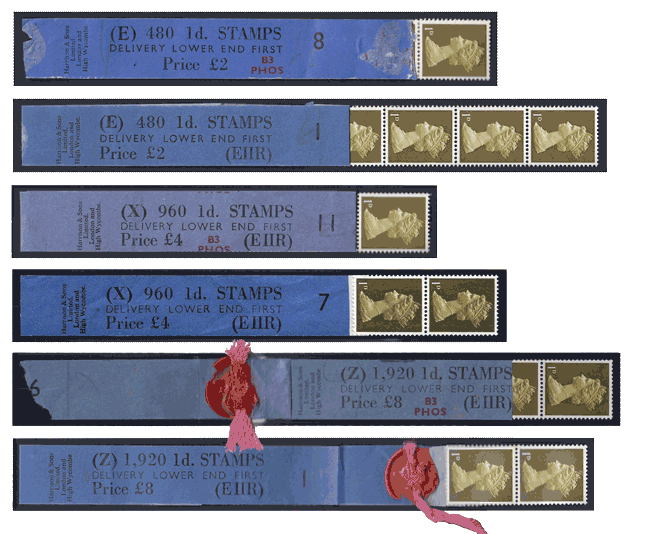
2d (V) rolls with 150 dpi, then 250 dpi phosphor screens (leaders are identical):
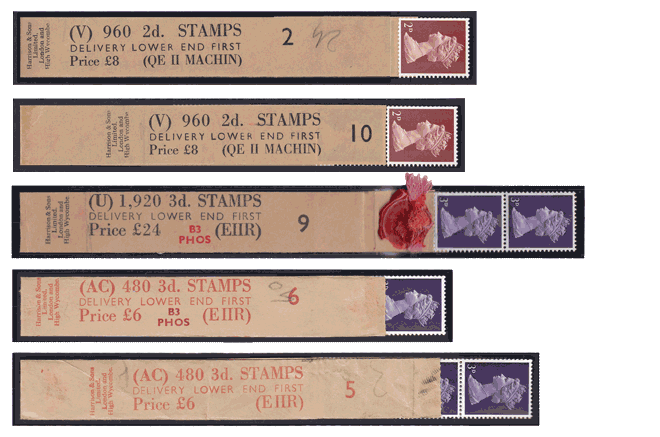
3d (AD) rolls with (cb, GA), then (2b, PVA) with and without overprint, then Head B:
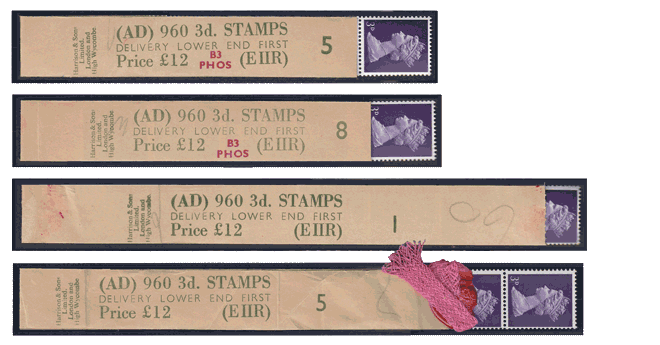
POKO Affixing Machines
Rolls for use in POKO affixing machines (A, AE) have 960 stamps, or (J) 480 stamps, wound lengthways, facing outwards, onto 1¼” diameter cores, for delivery lower end first.
4d (A) rolls in sepia (2b; GA), then sepia (cb; PVA), then bright vermilion (cb; PVA):
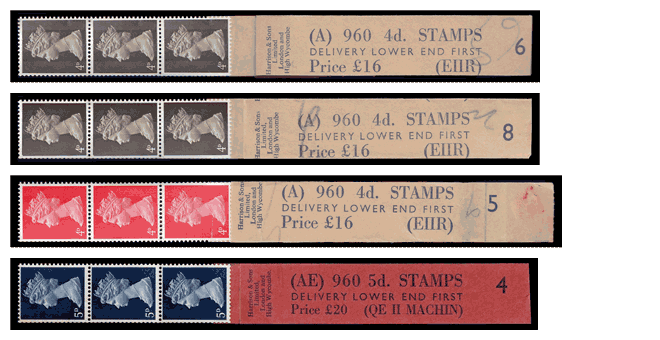
6d (J) rolls with 150 dpi, then 250 dpi phosphor screens:

FIXO Affixing Machines
No Machin rolls were issued for use in FIXO affixing machines (rolls (LR) had been discontinued).
Multipost Affixing Machines
Rolls for use in Multipost affixing machines (TSH, AF) have 480 stamps wound sideways, facing outwards, onto ½” diameter cores, for delivery left side first. Some (H) rolls were also used in a prototype Post Office vending machine at Cannon St, London which delivered three 4d stamps for one shilling.
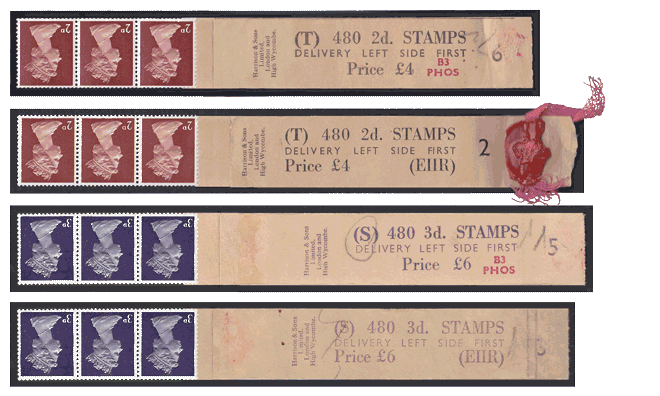
4d (H) rolls in sepia (2b; GA) with and without overprint, then sepia (cb; PVA), then bright vermilion (cb; PVA) Head A and Head B:
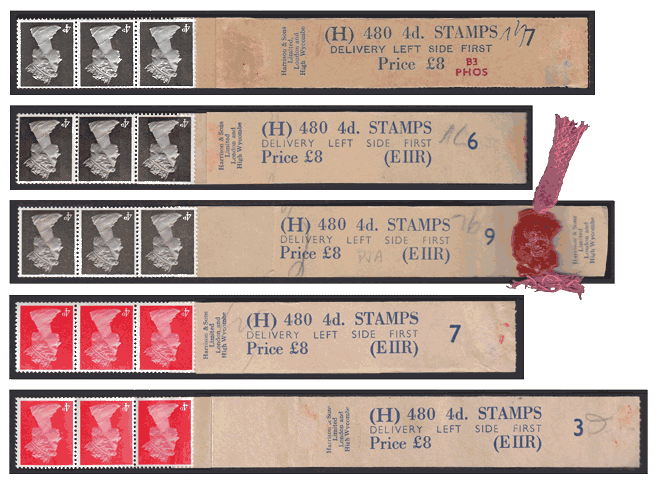
There are fewer than ten known copies of the above leader (4d bright vermilion with Head B). They were issued just before decimalisation and distribution was disrupted by a postal strike.

Multi Value Rolls
A new type of vending machine was introduced in 1969 in preparation for decimalisation. The “G” machine dispensed a strip of five stamps for a 1/- coin (or a 5 new pence coin). The strip had two 2d and one 3d, 1d, and 4d stamps, all Gum Arabic, Head B, phosphor screen 250 dpi.
Multi value rolls for use in Post Office vending machines (GS in black, GL in blue) have 1,500 or 3,000 stamps wound sideways, facing inwards, for delivery left side first.
| GS | MV | 1,500 | £15 | Left Side | Orange | c B cb |
| GL | MV | 3,000 | £30 | Left Side | Orange | c B cb |

Decimal Rolls
Although beyond the scope of this site, it’s interesting to take a quick look at the decimal rolls which replaced the £sd rolls. The 4d second-class rate was replaced by a 2½p rate, and the 5d first-class rate by a 3p rate. The 4d and 5d stamps could still be used with the addition of a 1p stamp to make up the rate.
| AS | 2½p | 500 | £12.50 | Left Side | Buff | cf. (H) |
| BS | 3p | 500 | £15 | Left Side | Buff | cf. (AF) |
| CL | 2½p | 1,000 | £25 | Lower End | Buff | cf. (A) |
| DL | 3p | 1,000 | £30 | Lower End | Buff | cf. (AE) |
| EL | 1p | 1,000 | £10 | Lower End | Brown | — |
| G1 | MV | 1,500 | £15 | Left Side | Red | cf. (GS) |
| G2 | MV | 3,000 | £30 | Left Side | Orange | cf. (GL) |

Other rolls followed as postal rates increased rapidly in subsequent years.